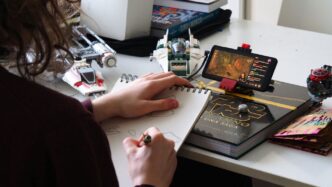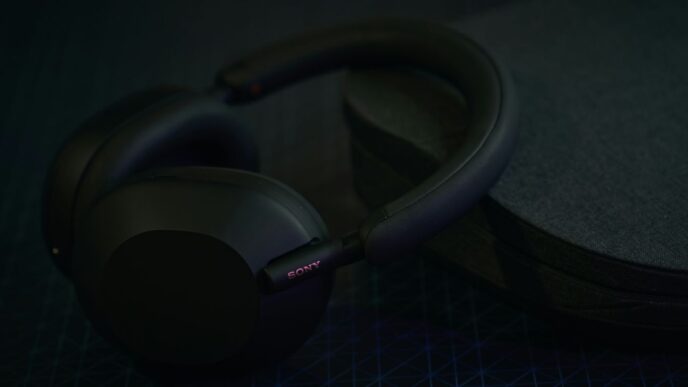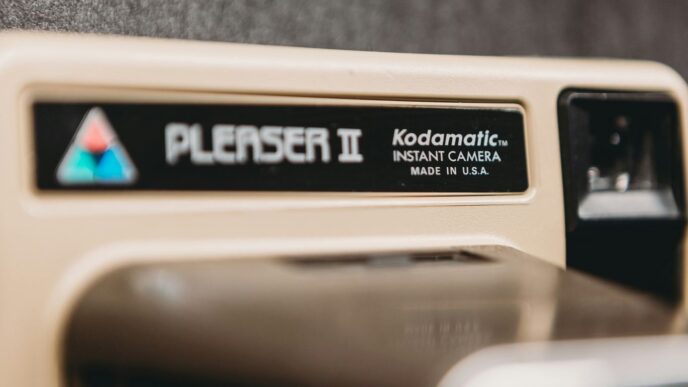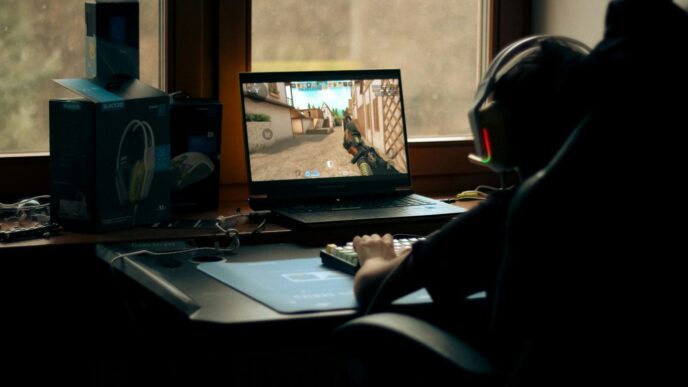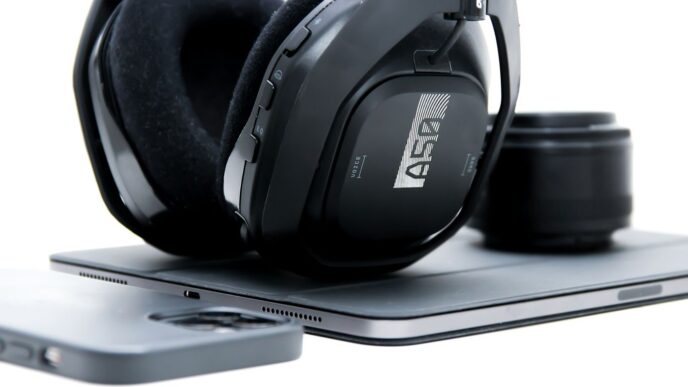So, everyone’s been buzzing about Valve Deckard, and honestly, it’s easy to see why. This new gadget from Valve could really change how we think about virtual reality, especially when it comes to playing games on the go. It promises to take the fun of VR and make it something you can easily carry around, kind of like the Steam Deck did for PC gaming. We’re all pretty curious to see what Valve has cooked up this time.
Key Takeaways
- Valve Deckard is expected to be a new portable VR headset, building on Valve’s work with the Steam Deck.
- Early hints suggest Valve Deckard will have advanced hardware, aiming for a better VR experience than what’s out there now.
- The device will probably fit right into the SteamVR system, making it easy for people to play their existing VR games.
- Valve seems to be putting a lot of thought into making sure Valve Deckard works well and is easy to use for everyone.
- This new device could really get more people into VR, possibly changing the market for portable virtual reality games.
Unveiling Valve Deckard’s Potential
Decoding the Initial Leaks
Okay, so the Valve Deckard. It’s been a long time coming, hasn’t it? We’ve all seen the whispers, the forum posts, the supposed "leaks" that pop up every few months. Honestly, sorting through what’s real and what’s just wishful thinking is half the battle. Some say it’s going to be a standalone VR headset, others think it’ll be more like a PC-tethered experience but with a lot more freedom than current headsets. Remember all the Steam Deck rumors before it actually came out? It feels a lot like that.
The Promise of Next-Generation Portable VR
The real excitement around the Deckard is the potential for truly portable VR. Think about it: no more base stations, no more being stuck in your living room. Imagine playing Half-Life: Alyx on your porch, or exploring a virtual world on a train. That’s the dream, right? Current portable VR is okay, but it’s still got a ways to go in terms of power and visual fidelity. If Valve can nail the balance between performance, battery life, and comfort, they could really change the game.
Anticipating Valve’s Next Big Leap
Valve has a history of doing things their own way. They don’t always follow the trends, and they’re not afraid to experiment. The Steam Deck was a pretty big gamble, and it paid off. So, what’s their plan with the Deckard? Are they trying to create a whole new VR ecosystem? Are they going to focus on [SteamOS mobile VR]? Will it be a device that can compete with the big players in the VR market? Only time will tell, but one thing’s for sure: everyone’s watching to see what Valve does next.
Hardware Innovations Driving Valve Deckard
Beyond Current VR Headsets
Okay, so everyone’s wondering what makes Valve Deckard different from the VR headsets we already have. It’s not just about slapping a screen on your face. We’re talking about a potential leap in technology. Think about current headsets – they’re often tethered to PCs, or if they’re wireless, they can be bulky and have limited processing power. Valve Deckard is rumored to be aiming for a sweet spot: standalone and wireless, but with enough horsepower to run demanding VR games. That’s the dream, right?
Speculated Technical Specifications
Let’s get into the nitty-gritty. What could be inside this thing? Well, nobody knows for sure, but here’s what people are guessing:
- Processor: There’s debate about whether Valve would go with an ARM-based system-on-a-chip (SoC) or stick with AMD. The Steam Deck uses an AMD APU, and some think Deckard might use a future version of that. It would make sense, given Valve’s experience with it. Christian Schildwaechter commented that it seems unlikely that Deckard would use an ARM SoC as its main processor, when Valve just released a gaming handheld based on a very power efficient AMD x86.
- Display: Higher resolution and refresh rates are a must. Think crystal-clear visuals and smooth motion. Maybe even micro-OLED displays for better contrast and color.
- Tracking: Inside-out tracking is pretty standard now, but Valve could be working on improvements to make it more accurate and less prone to drift. Maybe even incorporating some of the tech from their Index controllers.
- Battery: This is a big one. It needs enough juice to power the headset for a decent amount of time without turning into a brick. Battery life is always a challenge with portable devices.
Powering Immersive Experiences
So, what does all this tech mean for the actual VR experience? It’s about creating worlds that feel more real and responsive. Imagine playing a game where you can reach out and interact with objects naturally, without any lag or stuttering. That’s the goal. The Steam Deck essentially created a whole new device category, and Deckard could do the same for VR. It’s about pushing the boundaries of what’s possible in portable VR and revitalizing the stagnant virtual reality gaming segment. It’s about making VR more accessible and enjoyable for everyone.
The Valve Deckard Ecosystem
Seamless Integration with SteamVR
Okay, so the big thing here is how well Deckard plays with SteamVR. It’s not just about plugging it in and hoping for the best. Valve’s aiming for a super smooth experience right out of the box. Think about it: SteamVR is already a pretty established platform, and Deckard needs to slot right into that. That means:
- Easy setup: No crazy driver issues or complicated configurations.
- Universal compatibility: Works with existing SteamVR games and experiences.
- Automatic updates: Keeping everything running smoothly without you having to mess around.
It’s all about making VR more accessible, and a big part of that is making it less of a pain to set up and use. I’m hoping it’s as easy as they say.
Optimizing for SteamOS Mobile VR
SteamOS is Valve’s Linux-based operating system, and it’s what powers the Steam Deck. The idea is to bring that same kind of optimized experience to portable VR with Deckard. This is a big deal because mobile VR needs to be efficient to enable communication and not drain the battery in like, 20 minutes. Here’s what I’m expecting:
- Customized SteamOS: A version of SteamOS tweaked specifically for VR.
- Performance optimizations: Getting the most out of the hardware without sacrificing visual quality.
- Lower power consumption: Extending battery life for longer play sessions.
It’s a tricky balancing act, but if Valve can pull it off, it could make Deckard a real game-changer. I’m curious to see how they handle the thermal management too.
Ensuring Game Compatibility
This is where things get interesting. It’s not enough to just have a cool headset; you need games to play on it. Valve needs to make sure that existing SteamVR games work well on Deckard, and that new games are designed with portable VR in mind. Some things to consider:
- Backward compatibility: Making sure older games still look and play great.
- Developer support: Providing tools and resources for developers to optimize their games for Deckard.
- New VR content: Encouraging the creation of new and exciting VR experiences that take advantage of Deckard’s unique capabilities.
I think a big part of this will be working closely with developers to get them on board. Maybe even some exclusive titles to really show off what Deckard can do. We’ll see!
Valve’s Vision for Portable VR
Building on the Steam Deck Legacy
Valve’s success with the Steam Deck has clearly influenced their approach to portable VR. The Steam Deck proved that there’s a market for high-performance, handheld gaming devices, and Valve is looking to capitalize on that momentum with Deckard. They’re likely aiming to create a VR experience that’s as seamless and user-friendly as the Steam Deck, making VR more accessible to a wider audience. It’s not just about hardware; it’s about building an ecosystem that supports portable VR gaming. The Valve Index successor could really change the game.
Commitment to Virtual Reality Advancement
Valve has been a key player in the VR space for years, and Deckard represents their continued commitment to pushing the boundaries of what’s possible. They’re not just interested in creating another VR headset; they want to advance the entire VR industry. This means investing in new technologies, developing innovative software, and working with developers to create compelling VR experiences. Valve sees VR as the future of gaming and entertainment, and they’re dedicated to making that future a reality. They’ve been maintaining VR gaming on PC for a while now.
Addressing Industry Challenges
Portable VR faces several challenges, including performance limitations, battery life constraints, and the need for comfortable and ergonomic designs. Valve is well aware of these challenges, and they’re actively working to overcome them with Deckard. This involves developing new hardware solutions, optimizing software for mobile VR, and designing a headset that’s both powerful and comfortable to use for extended periods. They’re also focused on addressing the issue of motion sickness, which can be a barrier to entry for many VR users. Here are some of the challenges:
- Improving battery life for extended play sessions.
- Optimizing performance to deliver high-fidelity VR experiences on mobile hardware.
- Creating a comfortable and ergonomic design for long-term use.
Valve Deckard’s Impact on the VR Market

Challenging Existing Portable VR Devices
Okay, so let’s talk about how Valve Deckard could shake things up. Right now, the portable VR scene is… well, it’s got some players, but nobody’s really nailed it yet. You’ve got your standalone headsets, but they often feel like compromises. Deckard has the potential to really push the boundaries of what’s possible in a portable form factor. It’s not just about being wireless; it’s about bringing that high-end PC VR experience to something you can take on the go. If Valve can pull that off, it could seriously challenge the existing market and force other companies to step up their game. It’s like, are you ready for some competition?
Expanding the VR User Base
VR has been around for a while, but it still feels kind of niche, right? One of the biggest problems is accessibility. It can be expensive, complicated to set up, and sometimes just plain uncomfortable. But what if Deckard could change that? Imagine a VR headset that’s easy to use, doesn’t require a powerful PC, and offers a truly compelling experience. That could bring in a whole new wave of users who were previously turned off by the barriers to entry. Think about it: more users mean more developers, which means more content, which means even more users. It’s a snowball effect! And with the VR market’s potential in education and other sectors, the timing couldn’t be better.
Shaping the Future of Immersive Gaming
Let’s be real, gaming is a huge part of VR’s appeal. And Deckard could be a game-changer (pun intended). If Valve can deliver on the promise of high-fidelity, portable VR, it could completely reshape how we think about immersive gaming. Imagine playing your favorite SteamVR titles on the go, without sacrificing visual quality or performance. That’s the dream, right? Here are some ways Deckard could impact the future of immersive gaming:
- More focus on VR-first game design.
- Increased investment in VR game development.
- A blurring of the lines between PC and mobile VR gaming.
It’s not just about better graphics; it’s about creating entirely new kinds of gaming experiences that are only possible with portable, high-performance VR. And who knows, maybe we’ll even see some new games on Steam VR designed specifically for Deckard.
Overcoming Hurdles with Valve Deckard
Navigating Performance Expectations
Okay, so everyone’s hyped about the Valve Deckard, and rightfully so. But let’s be real, expectations are sky-high. The biggest challenge? Getting that sweet spot of performance and battery life. We’ve seen what the Steam Deck can do, but VR is a whole different beast. It needs to push way more pixels, and keep the framerate stable, or people are gonna get motion sickness faster than you can say "virtual reality." Valve will probably tune the system for VR, like they did with SteamOS for the Steam Deck, but it’s still a tough balancing act.
Addressing Hardware Limitations
Let’s talk about the elephant in the room: mobile hardware. Even if Valve throws in the latest and greatest chip, it’s still gonna be limited compared to a high-end gaming PC. This means compromises. Maybe lower resolutions, maybe simpler graphics. The key is to make those compromises smart. Here’s a few things they could do:
- Foveated rendering: Focus the processing power where the user is looking.
- Smart upscaling: Use clever algorithms to make lower-resolution images look sharper.
- Optimized game design: Work with developers to create VR experiences that are designed for mobile hardware from the ground up.
Ensuring a Polished User Experience
Hardware is only half the battle. The software needs to be on point too. Think about it: nobody wants to mess around with complicated settings or buggy interfaces when they just want to jump into a game. Valve needs to make sure the Deckard is easy to use, intuitive, and reliable. This means a smooth setup process, a stable operating system, and good integration with SteamVR. Plus, they need to get developers on board to create VR experiences that are actually fun and engaging. If they can nail all that, the Deckard might just have a shot at becoming the next big thing in VR.
What’s Next for Portable VR?
So, we’ve talked a lot about Valve’s Deckard, right? It’s pretty clear this thing could really change how we think about VR on the go. Imagine just grabbing your headset and jumping into a game, no big setup needed. That’s the dream, and Deckard seems like it’s trying to make that happen. It’s not just about playing games anywhere, it’s about making VR more common for everyone. We’ll have to wait and see what Valve actually brings out, but it feels like we’re on the edge of something big for portable virtual worlds. It’s exciting to think about.
Frequently Asked Questions
What exactly is Valve Deckard?
Valve Deckard is a new virtual reality headset that Valve, the company behind Steam, is rumored to be working on. Think of it like a Steam Deck, but for VR. It’s expected to be a portable device, meaning you can take your VR games with you, similar to a handheld console but for virtual worlds.
When will Valve Deckard come out?
Right now, Valve hasn’t officially announced Valve Deckard, so there’s no set release date. It’s still a rumor based on clues found in software and patents. People are hoping it will be the next big thing in portable VR, but we’ll have to wait for Valve to share more details.
How is Deckard different from other VR headsets?
Valve Deckard is expected to offer a more powerful and open VR experience compared to headsets like the Meta Quest. Since it’s from Valve, it will likely work very well with SteamVR, giving users access to a huge library of PC VR games without needing a separate, powerful computer. It might also have better graphics and features.
Can I play my current Steam VR games on Deckard?
Yes, it’s very likely that Valve Deckard will be designed to work easily with your existing Steam VR game library. Just like the Steam Deck lets you play many PC games on the go, Deckard should let you enjoy your virtual reality titles, making it simple to jump into your favorite VR worlds.
Will Valve Deckard be powerful enough for good VR?
People are hoping Valve Deckard will be quite powerful for a portable VR device. It’s meant to deliver high-quality virtual reality experiences, possibly even a step up from what’s currently available in a portable format. Valve is known for making strong hardware, so many expect it to handle demanding VR games well.
Why is Valve making a portable VR headset?
Valve seems to be building on the success of their Steam Deck, which made PC gaming portable. With Deckard, they want to do the same for virtual reality. Their goal is to make VR more accessible and easier to use for more people, letting them enjoy immersive worlds without being tied to a desktop computer. They want to push VR forward.



